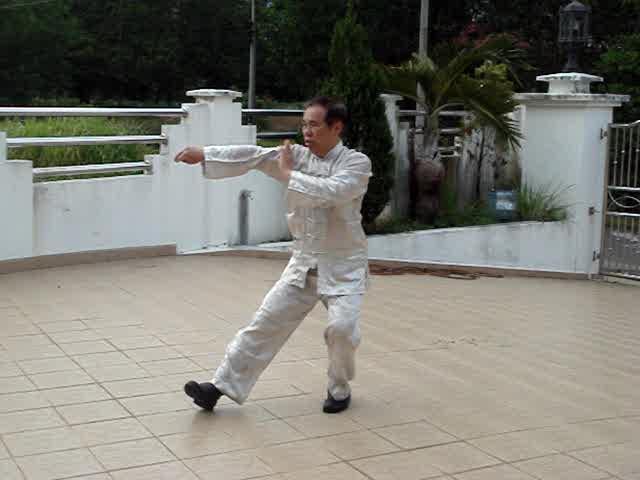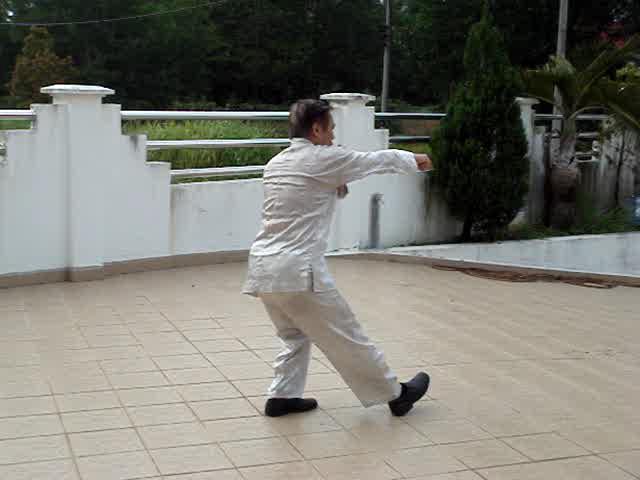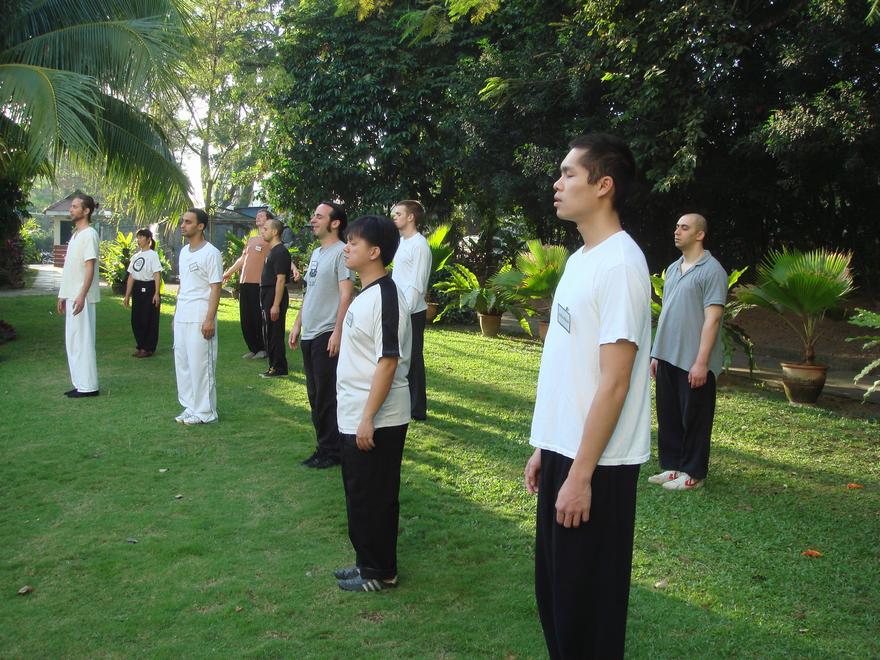SELECTION OF QUESTIONS AND ANSWERS
JUNE 2014 PART 3

Praying Mantis Kungfu is well known for its leg techniques
Question 1
Does the Praying Mantis Eighteen Collection Set come from the Seven Star, Plum Flower or Six Harmony styles/versions. Of course, it may be that you developed the set as the best combination of aspects of each.
— Sifu Barry Smale, UK
Answer
The Eighteen Collection Set in our school came from Seven-Star Praying Mantis, but it is also found in other schools of Praying Mantis like Plum-Flower and Six-Harmony, though there may be slight variations between the different Praying Mantis schools.
The set was composed by Wang Lang, the founder of Praying Mantis Kungfu. After graduating from the northern Shaolin Temple at Henan and following the advice of his master, the abbot of the temple, Wang Lang travelled all over China to meet other kungfu masters to test his skills. His master specially asked him to improve his footwork, which he did adopting the footwork of the Monkey Style.
Wang Lang fought with many masters in friendly sparring and collected the best from sixteen other styles. He combined them with his own original Praying Mantis Style and the Monkey Style to form the Eighteen Collection.
The 18 best techniques of the time were
- First Emperor's Long Fist as manifested in "Ascend Mountain Thrust Punch"
- Han Tong's Extended Arm as manifested in "Seven-Star Chop Fist"
- Zhang En's Close and Cover as manifested in "Distract Trick Chop Waist"
- Wen Yuan's Short Strike as manifested in"Seven-Star Turn Cart"
- Ma Ji's Close Combat as manifested in "Seven-Star Thrust Punch"
- Sun Heng's Monkey Style as manifested in "Jump Step Avoid Force"
- Huang Nian's Hand Anchor as manifested in "Ascend Mountain Elbow Strike"
- Mien Shen's Cotton Palm as manifested in "Double Cover Palm Strike"
- Jin Xiang's Deflect and Strike as manifested in "Cover Hand Thrust Punch"
- Huai De's Grab and Throw as manifested in "Slant Body Swing Hand"
- Liu Xing's Hook and Grip as manifested in "Grip Hand Lift Knee"
- Tan Fang's Ear-Strike as manifested in "Ascend Mountain Ear Strike”
- Yang Qing's Felling Techniques as manifested in "Double Hooks Sweep Leg"
- Lin Chong's Continuous Kicks as manifested in "Lift-Strike Lift Leg"
- Meng Su's Seven-Step Pressing as manifested in "Ascend Mountain Crush Fist"
- Cui Lian's Strike from Bosom as manifested in "Bottom Strike Lift Leg"
- Yang Gun's Gripping Techniques as manifested in "Ascend Mountain Double Fists"
- Wang Lang's Praying Manits as manifested in "Seven-Star Hook Hand"
These 18 techniques of Praying Mantis Kungfu can be found here.
Question 2
Is there anything special you would like to say about Praying Mantis?
Answer
The following are some interesting points about Praying Mantis Kungfu as well as about the Eighteen Collection Set.
Praying Mantis Kungfu was invented by Wang Lang during the Ming Dynasty in the northern Shaolin Temple. Later it branched out into six major schools, namely Seven-Star Praying Mantis, Plum Flower Praying Mantis, Taiji Praying Mantis, Six-Harmony Praying Mantis, Plain-Board Praying Mantis, and Eight-Step Praying Mantis.
Praying Mantis Kungfu is extensive in techniques and is well known for kicks. It is also effective for small-sized persons against bigger and stronger opponents. Some famous Praying Mantis sets, besides Eighteen Collection, are Crushing Step, Turn Cart and Avoid Force.
There is another kungfu style known as Southern Praying Mantis which is unrelated to the Praying Mantis Kungfu of Wang Lang. While Praying Mantis was derived from Northern Shaolin, Southern Praying Mantis was derived from Southern Shaolin. Southern Praying Mantis was popularly practiced by Chinese speaking the Hakka dialect.
Eighteen-Collection is from northern Praying Mantis. The set consists of the best 18 kungfu techniques of the time selected by Wang Lang from his sparring with other masters.
It is worthy of note that the term "Eighteen Collection" is chosen by me over the term "Eighteen Old Men" used by most Praying Mantis practitioners. In Chinese the set is known as "Shi Ba Sou". "Sou" can be interpreted as "old men" or "collection", besides other meanings which are not relevant in this context. The two Chinese words have the same pronunciation, but are written slightly differently today. As writing has evolved, I believe that the two words were written the same way in the past though their meanings were different.
This set consists of 18 best techniques. I believe it was more likely that Wang Lang collected these 18 techniques, rather than learning from 18 old men. Many of the masters from whom these techniques derived, including Wang Lang himself for his Praying Mantis style, were not old. Moreover, it could be insulting to refer to these masters as old men, especially “old men” as represented by the word “sou” suggested that these old men were not very intelligent.
Another interesting point about this Eighteen-Collection Set is the Seven-Star Step. Not many people know its application. It is very effective for trapping an opponent's leg, preventing him from moving away, or breaking his sheen, often without the opponent knowing. In the past I wondered why other kungfu styles did not adopt this Seven-Star Step if it was so useful.
Later I discovered that it had an innate weakness that kungfu masters might not risk using it. I also discovered some effective counters should opponents exploited the weakness of this pattern.

Do you know why this effective Seven-Star Stance is not widely adopted by other kungfu styles?
Question 3
Is there any difference in the way force is exploded in Taijiquan and in Xingyiquan?
— Sifu Riccardo Puleo, Italy
Answer
Yes, there is some difference. In Taijiquan, force is exploded from the dan tian. Hence, rotating the waist is very important. It generates the spiraling of force from the dan tian to the hand for striking. Past masters made things easy for us with the advice: start from the back leg, rotate the waist, and complete at the hand.
In Xingyiquan, force is exploded from the shoulder. This is possible with the Three-Body Stance. Unlike the Three-Circle Stance in Taijiquan and the Horse-Riding Stance in Shaolin Kungfu, the Three-Body Stance in Xingyiquan is asymmetrical.
At first I wondered why this stance for developing internal force is asymmetrical. I discovered the answer while preparing to teach Xingyiquan at the UK Summer Camp 2013 when I read in Xingyiquan classics about the “correspondence mode” and “expansion mode” while practicing the stance. The Three-Body Stance with the two modes enables force to be focused at the shoulder to be exploded out.
Nevertheless, when one has attained a master’s level whereby his whole body, including the pathway from his dan tian to his hands, is filled with energy, he can explode force from his wrist, irrespective of whether he is trained in Taijiquan, Xingyiquan, Shaolin Kungfu or any style.
Question 4
The Bow-Arrow Stance I learn in Wahnam Taijiquan is different from the same stance I learned in another Taijiquan school. Can you please explain?
— Claudio, Italy
Answer
The Bow-Arrow Stance we perform in our school, whether in Wahnam Taijiquan, Shaolin Kungfu or other kungfu styles, is quite different from that performed by other schools, though superficially they look the same. The differences are as follows.
The two feet of our Bow-Arrow Stance are in line. Suppose you are facing East in your right Bow-Arrow Stance. Both your front foot and your back foot are in the Ease-West alignment.
In the Bow-Arrow Stances of other schools, the feet are slightly apart. The front right foot is slightly on the right side of the East-West line, and the back left foot slightly on the left side.
In our Bow-Arrow Stance, both the front foot and the back foot are hooked in. The front foot points to North-East, and the back foot also points to North-East or East-North-East.
In the Bow Arrow Stance of other school, the front foot points to the East and the back foot points to the North or North-East.
In our Bow-Arrow Stance, the front knee does not bend beyond the front ankle. When you view the stance from a side, it resembles a pyramid shape.
In the Bow-Arrow Stance of some schools, the front knee bends beyond the front ankle. Viewing from a side, one can see the front knee makes a sharp angle.
From our Shaolin Wahnam perspective, we consider that the Bow-Arrow Stance performed by these other schools is wrong. It is wrong not because it is different from ours, but because it causes harmful side-effects like knee injuries and back pain.
When the front knee is bent too far forward making a sharp angle, it causes energy blockage at the knee, resulting in knee injuries. When the two feet make a L-shape instead of are being hooked in, energy is dissipated instead of being focused at the dan tian. This position also puts stress on the back muscles, causing back pain.

The Bow-Arrow Stance performed in many other schools is quite different from that we perform in our school. Can you tell the difference?
Question 5
Can you please explain why yin-yang harmony is important in chi kung and in everyday life?
— Juliana, Austria
Answer
If one does not have yin-yang harmony, he would have a weakness of double yang, or worse he would have yin-yang disharmony. These are technical terms, and will become clear when we examine some examples in chi kung and in everyday life.
Yin and yang are widely used terms in Chinese philosophy, but not many people, including Chinese, really know what they mean.
Yin and yang are two terms symbolizing two complimentary aspects of reality. One aspect is represented as yin, and the other aspect as yang. By convention, what is feminine, gentle, unknown, negative, dark, small and substantial is represented as yin, and their counterparts, i.e. masculine, forceful, known, positive, bright, big and functional is represented as yang.
This does not mean that all feminine persons are yin, and all forceful events are yang. Yin and yang are applied only when there is comparison, and sometimes the comparison is understood, not explicitly stated.
For example, let us take two women. If the point of comparison is their size, the smaller-sized woman is yin, and the bigger-sized woman is yang. If the point of comparison is gender, then both of them are represented as yin. Here the comparison is understood, not explicitly mentioned. We compare the women with men.
In chi kung training, there are two dimensions, namely building energy and circulating energy. When we compare these two dimensions, building energy being relatively stationary is represented as yin, and circulating energy being mobile is represented as yang. If a practitioner only builds energy without circulating it, he does not have yin-yang harmony.
He commits a weakness of double yang. Why is it not called a weakness of double yin, since building energy is represented as yin? In the case of the weakness, the comparison is not between building and circulating, it is between what is known and what is not known. What is known is that building energy is good, but what is not known is that not circulating it is bad. What is known is represented as yang. Hence, it is a weakness of double yang.
There is no such a term as a weakness of double yin. If another practitioner just circulates energy without building energy, it is also called a weakness of double yang.
If the practitioner continues to build energy without circulating it, he will eventually be sick. This is represented as yin-yang disharmony. The cause of the disharmony here is excessive yin.
In daily life, being at home is represented as yin, and working outside is represented as yang. Now we have a man who is a good husband, washing dishes and looking after children at home, but he does not go out to work. He does not have yin-yang harmony.
He commits a weakness of double yang. He knows that washing dishes and looking after children for his wife is good, but he does not know that it is also important for him to go outside to work. If he does not rectify his weakness of double yang, he may eventually have financial, family or social problems, represented as yin-yang disharmony.
Some examples of yin-yang harmony in chi kung are being peaceful as well as energetic, being solid as well as being agile, physically fit as well as mentally healthy. Some examples of yin-yang harmony in everyday life are being successful in private life as well as public life, able to retreat as well as to exert, being able to enjoy leisure as well as to work hard.
Question 6
Can I become a master of chi-kung without a teacher?
— Sasha, Russia
Answer
No, you can't become a chi kung master without first learning from a teacher. You can't even become a genuine chi kung practitioner. You should learn not just from any teacher, but from a competent teacher.
A main reason why many people do not realize that one cannot become a genuine chi kung practitioner without learning from a competent teacher is that they do not realize the difference between knowledge and skill.
Knowledge is theoretical and can be learned from books. Skill is practical and has to be learned from a living teacher.
When a student goes to medical school, what he reads from books is knowledge. He knows, for example that antibiotics are effective against bacterial infections, and a patient's liver detoxifies poisons. How much antibiotics he prescribes to his patient, or how he diagnose that a patient's liver is not functioning normally are skills.
One can read from books why chi kung can overcome illness and promote vitality, and what chi kung exercises are suitable for these purposes. This is knowledge. You can have a lot of such knowledge without having to learn personally from a teacher.
But whether you can perform these exercises so that you can overcome illness and promote vitality concerns skills, which you cannot get by reading from books, You have to learn these skills personally not from any chi kung teacher but from a competent teacher willing and able to pass these skills to you.

Entering a chi kung state of mind, also called entering Zen or entering Tao, is an essential skill in chi kung, but shockingly not many chi kung practitioners today have this skill
Question 7
I just don't have an opportunity to practice with a master. If I can become a chi kung master on my own, what do I need, what exercises do I need to do?
Answer
It is like saying that you want to learn swimming but you don't have an opportunity to practice with a swimming instructor. You just have to create that opportunity, regardless of whether it is swimming or chi kung.
You may learn swimming techniques from books or videos, but you won't be able to swim.
You may learn chi kung techniques from books or videos, but you won't be able to practice chi kung.
There is one big difference in the analogy. You can easily know that you can't swim, but it is not easy for you to know that you are not practicing chi kung. You may honestly think you are practicing chi kung when actually you are just performing gentle physical exercise. In fact, more than 80% of chi kung practitioners all over the world, including "masters", are doing just this.
Question 8
If my level of practice is equal to that of a master, can I do some advanced techniques like flow of chi without the help of a master?
Answer
Like many other people, you have greatly underestimated the ability of chi kung masters and overestimated your own ability. You think, wrongly, that one can become a chi kung master by practicing some chi kung exercises learned from books or even learned from a living teacher.
This mistaken view is very common. In fact there are thousands of such "masters" today, and many of them are highly regarded by the ignorant public. Actually these "masters' are not even practitioners of genuine chi kung. Many of them are sick and have to take medication on a routine basis.
Chi flow is not an advanced technique. It is one of the very first things students in our school learn, and this skill is fundamental, meaning very important. Fresh beginners in my Intensive Chi Kung Course experience chi flow in the first 15 minutes. By the end of the 2-hour session, they can generate a chi flow on their own without the help of a master.
LINKS
Selected Reading
- Lineage of Shaolin Wahnam
- A Strategy in Seven Steps
- 108-Pattern Tiger-Crane Set
- A Lesson from the Ireland Course 2014
- Beautiful Places
